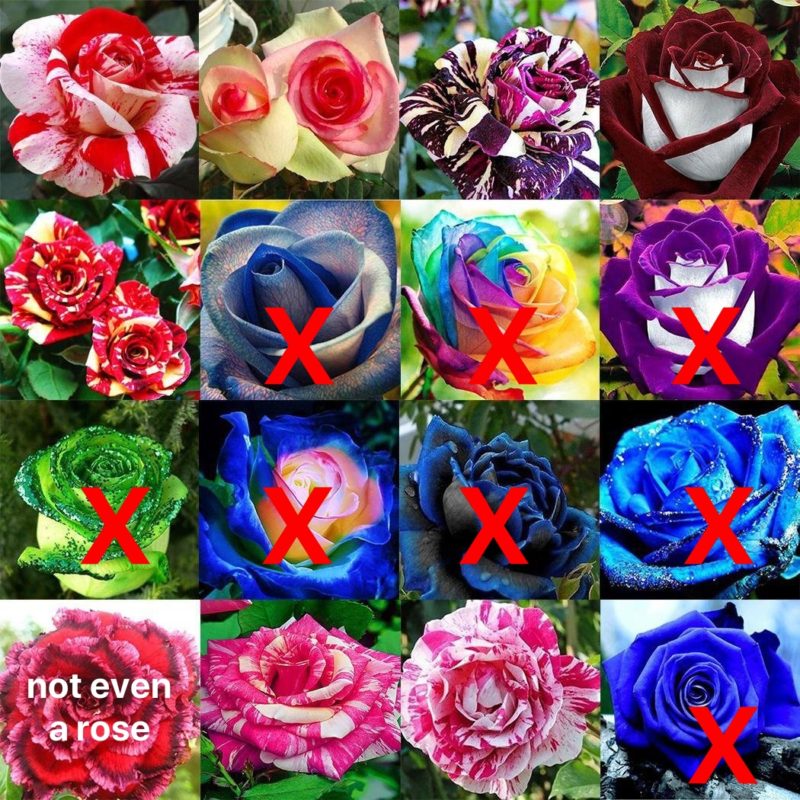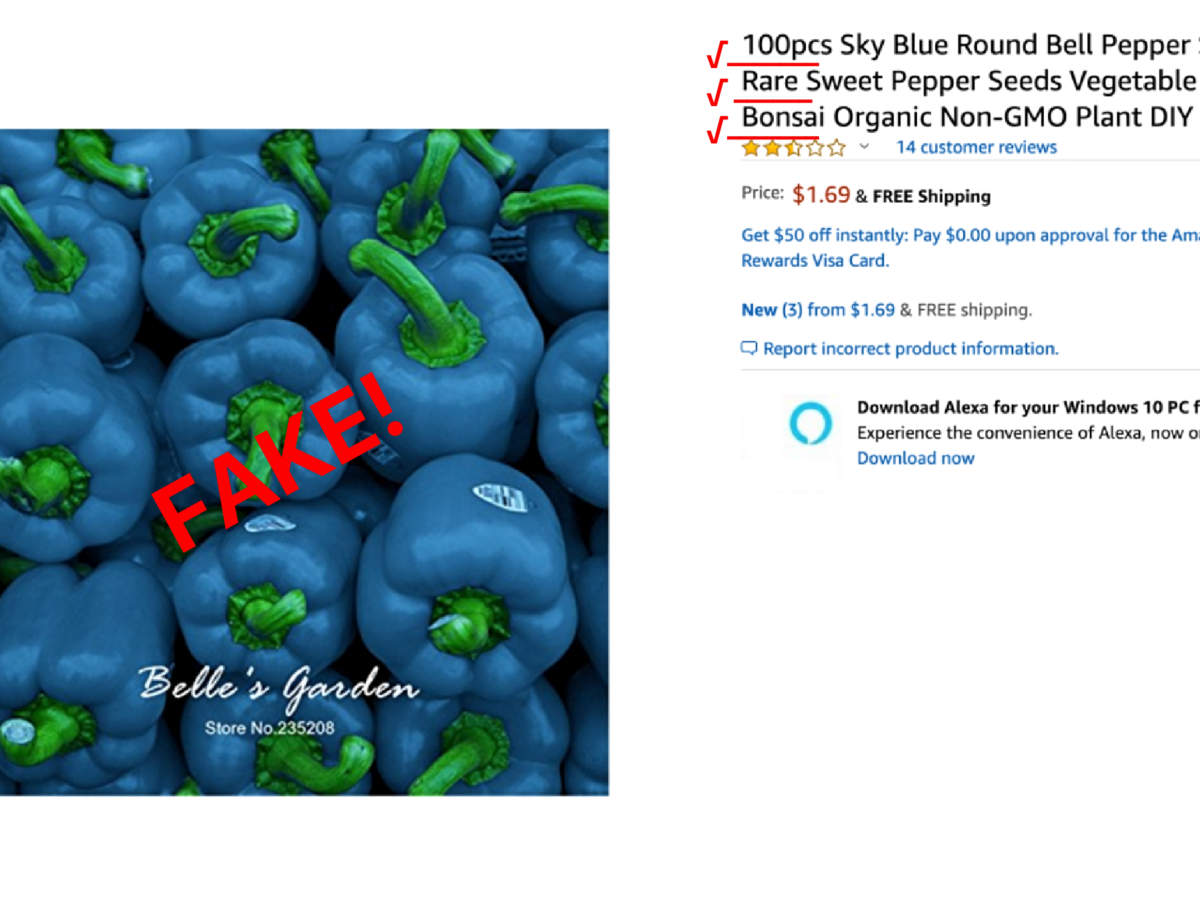
Don’t Be Fooled By These Ridiculous Online Seed Scams
Buyer beware: These plants look completely fake because they are (except for the peter peppers — those are actually real)

Photo by DigiPub / Getty Images
If you spend any time shopping for plants online, you may have noticed some pretty kooky-looking items sliding into your algorithms lately: ultraviolet strawberries, roses with every petal a different color of the rainbow, gourds that look like pendulous human breasts. You may have also noticed that seeds for these plants are for sale—by lots of sellers—and they look too good to be true. Well, that’s because they are! Welcome to the completely unhinged world of online seed scams.

The red Xs are fake, Photoshopped roses. The upper right rose is a real variety (‘Osiria’); the photo has been flipped and recolored to produce the fake purple rose in the photo directly below it.
This bizarre phenomenon has been getting more news recently, but a Reddit post from three years ago shows that these seed scams have been making the rounds for a while. Some of the seeds are sold under the category of “toys/games,” which might be how sellers are getting away with obvious fraud. Also, Amazon and eBay allow only 30 to 45 days for returns, respectively, but it takes longer than that for seeds to grow into plants (if they even germinate at all), buying the sellers plenty of time before they’re found out. While Amazon acknowledges that there’s a problem with scammers and piracy, they’ve built in what is basically a “shrug emoji” clause into their annual earnings report that relieves them from any responsibility to stop it.
Here are some tips for avoiding the seed scams at online retailers.
If It Looks Fake, It Probably Is
The use of Paul Mauriat’s “Love Is Blue” as the song in this video is either truly inspired or a subtle troll on the buyers naive enough to believe these cartoonish plants are real.
I am so sorry to be the bearer of bad news, but it can’t come as a shock that day-glo blue strawberries simply do not exist, in nature or otherwise. A lot of seed scams play upon the wish for magic beanstalks to be real, and employ plenty of Photoshop to sell the dream. Mostly, though, it’s simply that buyers honestly don’t know that there’s no such thing as a purple-fleshed watermelon or that mushrooms don’t even come from seed, let alone grow in rainbow colors. Sometimes the seller doesn’t even bother trying to find different images to alter for their products (as seen in the rose example above), and will simply change the color on the same exact photo.
Beware of these common offenders: purple watermelon, blue bell peppers, rainbow tomatoes, technicolor strawberries (FYI, pretty much any shade besides red, pink, or white are fake), and breast gourd, which was actually a series of silicon sculptures created by a Vietnamese artist named Nguyen Thi Hoai Mo.
Some of These Are Real, but Won’t Grow That Way from Seed

These Buddha pears are real, but they don’t come from seeds! Photo courtesy of Fruit Mould Company
To further confuse matters, some of the plants offered by these sellers are actually real, but you can’t grow them from seed. For example, cubical watermelons in Japan are real, but they’re created by placing the young fruit inside a box while it grows (same goes for Buddha-shaped pears—they’re grown in a mold); rainbow carnations are made by sticking the cut stems into dyed water.
Some other plants are also real, and do grow from seeds, but the seeds being sold by these sellers aren’t for the plants pictured. For example, peter peppers are absolutely real (they make a great conversation starter for your next crudités platter) but the seeds that arrived when some buyers made their purchase produced regular old cayenne-type chiles. This is when it’s particularly important to shop from trusted (preferably local) sources. Monkey face orchids are also real, but you have to buy them from orchid specialists—they’re rare and not just going to grow from some $4 seed.
Check the Item Description

The item descriptions for these fake seeds will usually include some combination of the terms “rare” (or “very rare”); “bonsai,” even though it’s not a bonsai being sold; and “organic/GMO free.” Sometimes they tack on other terms like “DIY” just to get more hits. They’ll also typically list the number of seeds as “pcs” (seeds are normally sold by weight rather than quantity). Most of these sellers are in Hong Kong or China, but some fraudulently advertise their seeds as “USA grown.”
Sometimes the seller will deploy an array of details that have absolutely nothing to do with the item at hand, like in this kiwi strawberry (which, come on, could not be more obviously fake):

In addition to noting the seed scam dead giveaways (underlined in red in the screen shot above), read the details in the bullets. What exactly does “the smell of herbs” or “beautiful flowers for floral arrangements” have to do with this barmy cross-genera mutant? Nothing.
Read the Reviews
It won’t always be all one-star reviews, either—but you should be just as skeptical of items that have all five-star ratings with one-sentence reviews. The five-star reviews will often be nothing more than a string of meaningless words or a generic “works great!” type review that was written by fake accounts.
🌿
A final note on rare plants: plenty of real growers of heirloom plants and rare species need support to keep vintage and heritage plant varieties alive. Visit plant sales held by local botanical gardens and give them your money instead!
